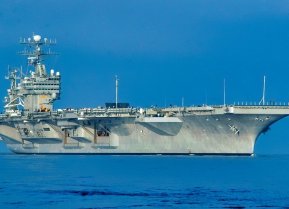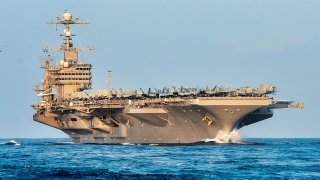USS John C. Stennis: The Navy Aircraft Carrier America's Enemies Freak Over
The seventh Nimitz-class carrier to hit the waters was the USS John C. Stennis, named to honor the Mississippi state Senator. Like her sister ships, CVN-74 was designed to conduct sustained combat air operations while forward-deployed.
USS John C. Stennis aircraft carrier profile: The Navy’s Nimitz-class aircraft carriers may remain in service longer than their projected retirement dates. Due to delays in the development of the Nimitz-class replacement - the Ford-class - in addition to the growing demand for the carriers overall, this aging platform is still a necessary asset for the service.
Last year, the Navy launched a study investigating how the Nimitz-class could fit into the service’s 30-year shipbuilding plan. According to reports, the study concluded that the Navy should be capable of maintaining a fleet of 11 aircraft carriers, including the new Ford-class vessels, through at least the 2039 Fiscal Year.
As tensions between Washington and Beijing continue to ramp up in the South China Sea, as well as the ongoing crises in the Middle East, U.S. aircraft carriers are needed for adequate deterrence and power projection.
An Overview of the Nimitz-Class Carriers
Originally constructed in the late 1960s, the Navy’s Nimitz-class aircraft carriers were designed to replace the service’s aging Kitty Hawk, Forrestal and Enterprise-class ships.
Unlike their predecessors, the Nimitz-class ships carry only two reactors. As only two Westinghouse A4W nuclear reactors are necessary to power these aircraft carries, the ships’ top speed is much higher than its counterparts. The Nimitz carriers can also carry 90% more aviation fuel and 50% more ordnance than its Forrestal-class predecessors.
Until the development of the USS Gerald R. Ford (CVN-78), the Nimitz-class nuclear-
Armament-wise, these ships can pack a punch. All Nimitz-class carriers are equipped with two 21-cell Sea RAM and two MK29 Sea Sparrow missiles, four Mk 38 25mm autocannon turrets as well as two PHALANX CIWS Close-In Weapons System Gatling guns.
What is so special about the Nimitz carriers?
One of the most significant enhancements that the Nimitz-carriers possess is the incorporation of the cutting-edge GPS-enabled aircraft carrier landing system called Joint Precision Approach and Landing System. This new system enables pilots landing on moving carriers to be guided by more precise technology.
Specifically, this system was designed to accommodate and better support the arrival of the F-35C Lightening II fighters to the flight deck.
Overall, each of the 10 Nimitz-class sister ships can lug up to 60 airframes, including various fixed-wing and rotary-wing aircraft with up to 90 different types.
The incorporation of steam catapults into the Nimitz-class ships allowed the carriers to get away with shorter runways.
As detailed by Popular Mechanics: “Steam is diverted from the ship’s boilers—steam boilers powered by the ship’s nuclear reactors—and piped up to just under the flight deck, where it is held and pressurized in special tanks. In the meantime, the front landing gear of a carrier aircraft is loaded onto a small, plate-sized shuttle. When the aircraft is ready for launch, the steam is suddenly released and, in a burst of power, accelerates the shuttle—and attached aircraft—down the flight deck to takeoff speeds.”
Introducing USS John C. Stennis (CVN-74)
The seventh Nimitz-class carrier to hit the waters was the USS John C. Stennis, named to honor the Mississippi state Senator. Like her sister ships, CVN-74 was designed to conduct sustained combat air operations while forward-deployed. The ship was first laid down in 1991 by Newport News Shipbuilding company and launched two years later.
The hefty carrier received its first deployment orders in the late 1990’s, when she was sent to the Persian Gulf. After completing her sea trials the John S. Stennis returned back to the Gulf in 2000 to enforce the no-fly zone in Iraq.
The ship would remain in the Middle East for several years, where she served against forces in Afghanistan shortly after the 9/11 terrorist attacks.
By 2009, the John C. Stennis would make its way towards the western Pacific.
As detailed by Military History, “John C. Stennis departed Bremerton for a 6-month deployment to the Western Pacific on 13 January 2009. On 24 April, the ship arrived in Singapore. That same day, one of the ship's sailors was crushed and killed while working from a small harbor boat to secure a drain that discharges oily water from John C. Stennis's aircraft catapults. On 29 April, the ship's executive officer, Commander David L. Burnham, was relieved by Rear Admiral Mark A. Vance over unspecified personal conduct. Burnham was reassigned to a base in San Diego, pending an investigation. After participating in exercises with Japan Maritime Self Defense Force and the Republic of Korea, as well as joint exercise Northern Edge 2009, John C. Stennis returned from deployment in early July 2009. Carrier Air Wing 9 debarked on 6 July at NAS North Island,[14] prior to the ship's arrival at her homeport of Bremerton on 10 July.”
About the Author, Maya Carlin
Maya Carlin is an analyst with the Center for Security Policy and a former Anna Sobol Levy Fellow at IDC Herzliya in Israel. She has by-lines in many publications, including The National Interest, Jerusalem Post, and Times of Israel. You can follow her on Twitter: @MayaCarlin.


